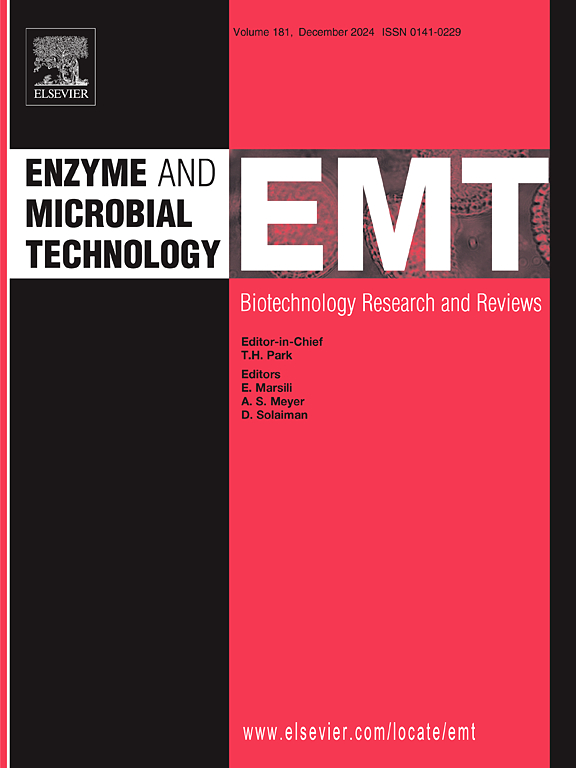静磁场对黄杆菌m1-14形态发生的影响机制
IF 3.7
3区 生物学
Q2 BIOTECHNOLOGY & APPLIED MICROBIOLOGY
引用次数: 0
摘要
静磁场的生物效应一直是学术界的研究热点。虽然磁场对微生物形态发生的影响与微生物发酵效率密切相关,但其具体机制尚未完全阐明。在本研究中,将产生维生素k2的菌株Flavobacterium sp. m1-14暴露在高达9 Tesla (T)的静态磁场中24 h。观察到细菌细胞缩小,整体大小呈减小趋势。长度、宽度和纵横比分别减少约25.27 %、14.28 %和17.95 %。此外,细菌的生理生化特性也发生了显著变化。细胞膜通透性增加约6.2 %;Na + -K + -ATPase和Ca 2 + -Mg 2 + -ATPase的活性分别下降了约57.5 %和34.7 %;膜电位明显降低。此外,细胞内ATP水平下降了约12% %,这一变化直接归因于ATP代谢受损。对关键形态调控基因mreB和ftsZ的研究发现,它们的转录水平分别被调控190 %和38 %,这可能是细胞能量缺乏引起的应激反应。在mreB和ftsZ高表达的条件下,细胞缩小体积以减少代谢损失,从而适应极端环境。本文章由计算机程序翻译,如有差异,请以英文原文为准。
Mechanism of static magnetic field influencing morphogenesis of Flavobacterium sp. m1-14
The biological effects of static magnetic fields (SMF) have long been a research hotspot in academia. While the impact of magnetic fields on microbial morphogenesis is closely linked to microbial fermentation efficiency, the specific mechanism remains incompletely elucidated. In this study, the vitamin K2-producing strain Flavobacterium sp. m1–14 was exposed to a static magnetic field of up to 9 Tesla (T) for 24 h. It was observed that the bacterial cells shrank, showing an overall decreasing trend in size. The length, width, and aspect ratio decreased by approximately 25.27 %, 14.28 %, and 17.95 %, respectively. Furthermore, the physiological and biochemical properties of the bacteria underwent significant changes. Specifically, the cell membrane permeability increased by approximately 6.2 %; the activities of Na⁺-K⁺-ATPase and Ca²⁺-Mg²⁺-ATPase decreased by about 57.5 % and 34.7 %, respectively; and the membrane potential decreased significantly. In addition, intracellular ATP levels decreased by approximately 12 %, a change directly attributed to impaired ATP metabolism. Investigations into the key morphological regulatory genes mreB and ftsZ revealed that their transcription levels were unregulated by 190 % and 38 %, respectively—likely a stress response induced by cellular energy deficiency. Under conditions of high mreB and ftsZ expression, cells reduce their size to minimize metabolic loss, thereby adapting to extreme environments.
求助全文
通过发布文献求助,成功后即可免费获取论文全文。
去求助
来源期刊

Enzyme and Microbial Technology
生物-生物工程与应用微生物
CiteScore
7.60
自引率
5.90%
发文量
142
审稿时长
38 days
期刊介绍:
Enzyme and Microbial Technology is an international, peer-reviewed journal publishing original research and reviews, of biotechnological significance and novelty, on basic and applied aspects of the science and technology of processes involving the use of enzymes, micro-organisms, animal cells and plant cells.
We especially encourage submissions on:
Biocatalysis and the use of Directed Evolution in Synthetic Biology and Biotechnology
Biotechnological Production of New Bioactive Molecules, Biomaterials, Biopharmaceuticals, and Biofuels
New Imaging Techniques and Biosensors, especially as applicable to Healthcare and Systems Biology
New Biotechnological Approaches in Genomics, Proteomics and Metabolomics
Metabolic Engineering, Biomolecular Engineering and Nanobiotechnology
Manuscripts which report isolation, purification, immobilization or utilization of organisms or enzymes which are already well-described in the literature are not suitable for publication in EMT, unless their primary purpose is to report significant new findings or approaches which are of broad biotechnological importance. Similarly, manuscripts which report optimization studies on well-established processes are inappropriate. EMT does not accept papers dealing with mathematical modeling unless they report significant, new experimental data.
 求助内容:
求助内容: 应助结果提醒方式:
应助结果提醒方式:


